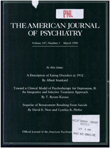Graphic representation of the life course of illness in patients with affective disorder
Abstract
The authors illustrate methods for the graphic depiction of the course of unipolar and bipolar affective illness. The utility and advantages of such an approach include 1) accurate assessment of episode patterns, 2) elucidation of relationships to environmental events, endocrine and seasonal factors, and psychosocial stressors, 3) better delineation of treatment response, 4) a greater understanding of the longitudinal and characteristic patterns of illness, and 5) the associated better patient management with psychotherapeutic and pharmacological interventions.
Access content
To read the fulltext, please use one of the options below to sign in or purchase access.- Personal login
- Institutional Login
- Sign in via OpenAthens
- Register for access
-
Please login/register if you wish to pair your device and check access availability.
Not a subscriber?
PsychiatryOnline subscription options offer access to the DSM-5 library, books, journals, CME, and patient resources. This all-in-one virtual library provides psychiatrists and mental health professionals with key resources for diagnosis, treatment, research, and professional development.
Need more help? PsychiatryOnline Customer Service may be reached by emailing [email protected] or by calling 800-368-5777 (in the U.S.) or 703-907-7322 (outside the U.S.).



